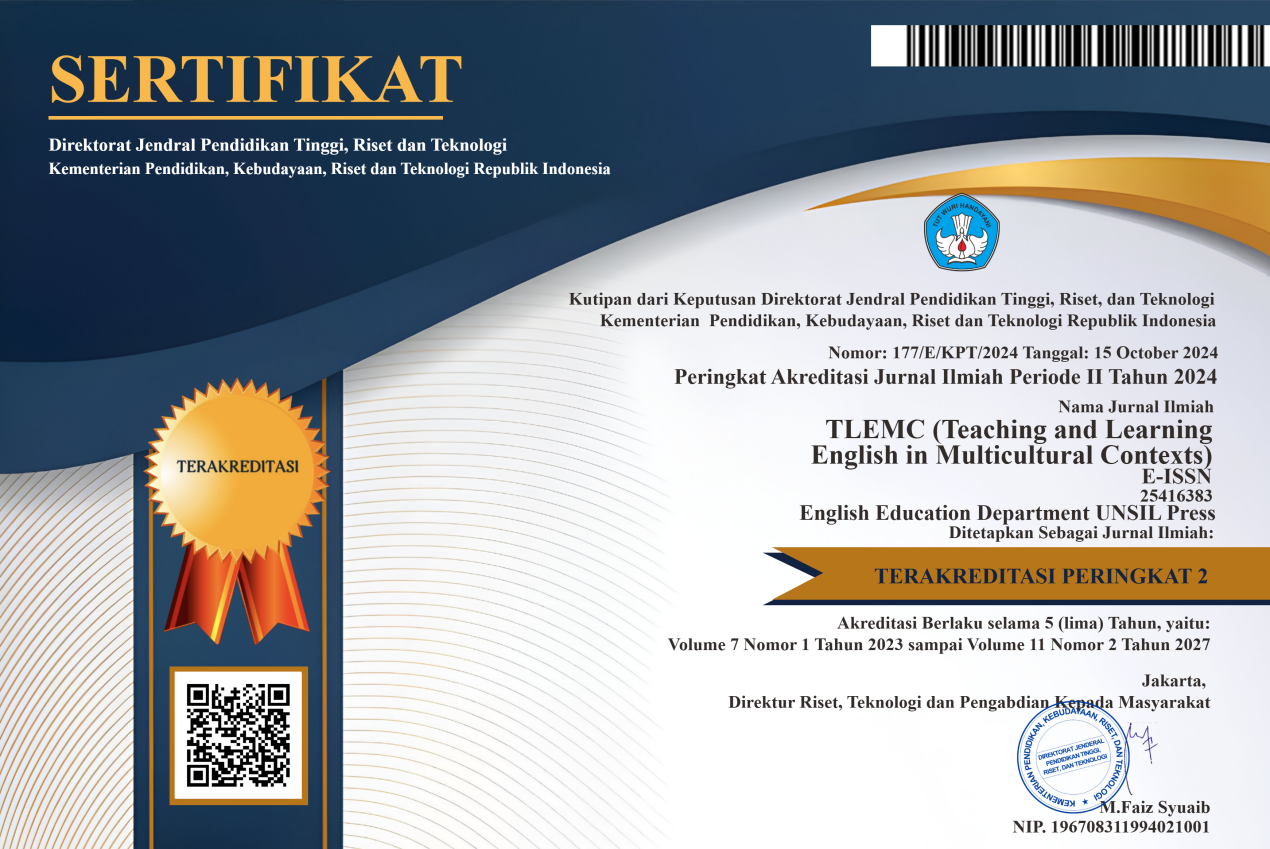THE CORRELATION BETWEEN SELF-ESTEEM AND SPEAKING PERFORMANCE IN INDONESIA
Abstract
Full Text:
PDFReferences
Alters, S., Schiff, W. (2011). Essential concepts for healthy living update (5th ed). Sudbury: Jones and Bartlett Publishers.
Ana, O.S., (2003). Brown tide rising: Metaphors of latinos in contemporary American public discourse (2nd ed). USA: University of Texas Press.
Brown, H. D. (2000). Principles of language learning and teaching (4th ed). New York: Longman.
Brown, H. D. (2001). Teaching by principles: An interactive approach to language pedagogy. New York: Longman.
Brown, H.D., Abeywickrama P. (2010). Language assessment: Principles and classroom practices (2nd ed). White plains, NY: Pearson Longman.
Bygate, M. (1987). Speaking. Oxford: Oxford University Press.
Coolidge, F. L. (2000). Statistics: A gentle introduction. London: SAGE Publications.
Coopersmith, S. (1967). The antecendents of self-esteem. San Fransisco: Freeman.
De Bot, K., Lowie, W., Verspoor, M. (2005). Second language acquisition: An advanced resource book. New York: Routledge.
Depdiknas. (2006). Peraturan menteri pendidikan nasional republik Indonesia nomor 22 tahun 2006 tentang standar Isi untuk satuan pendidikan dasar dan menengah. Jakarta: Depdiknas.
Depdiknas. (2016). Peraturan menteri pendidikan nasional republik Indonesia nomor 24 tahun 2016 tentang KI dan KD mata pelajaran kurikulum 2013. Jakarta: Depdiknas.
Efrizal, D. (2012). Improving students’ speaking through communicative language teaching method at MTS Ja-alhaq, sentot ali basa islamic boarding school of Bengkulu, Indonesia . International Journal of Humanities and Social Science, 2(20), 127-134.
Evans, J. D. (1996). Straightforward statistics for the behavioral sciences. Pacific Grove, CA: Brooks/Cole Publishing.
Febriyanti, E. R. (2011). Teaching speaking of english as a foreign language: Problems and solutions. Jurnal Bahasa, Sastra, Dan Pembelajarannya, 1(6), 1-16.
Ghozali, I. (2005). Aplikasi analisis multivariate dengan program SPSS (3rd ed). Semarang: Badan Penerbit Universitas Diponegoro.
Gravetter, F. J., & Forzano, L.-A. B. (2016). Research methods for the behavioral sciences. USA: Cengange Learning.
Gravetter, F. J., & Wallnau, L. B. (2008). Essentials of statistics for the behavioral sciences. USA: Cengange Learning.
Gustaman, W. W. (2015). The correlation between students' self-eeteem and their english speaking competencies (Research paper). Indonesia University of Education, Bandung, Indonesia.
Hamied, F. A., & Malik, R. S. (2016). Research methods: A guide for first time researchers. Bandung: UPI PRESS.
Harmer, J. (2007). The practice of english language teaching. UK: Longman.
Hughes, A. (2003). Testing for language teachers (2nd ed). Cambridge: Cambridge University Press.
Johnson, R.B., Christensen, L. (2014). Educational research: Quantitative, qualitative, and mixed approaches (5th ed). USA: SAGE Publication.
Kalanzadeh, G.-A., Mahnegar, F., Hassannejad, E., & Bakhtiarvand, M. (2013). Their infuence of EFL students' self-esteem on their speaking skills. The International Journal of Language Learning and Applied Linguistics World, 2(2), 76-83.
Mukminin, A., Masbirorotni, Noprival, Sutarno, Arif, N., & Maimunah. (2015). EFL speaking anxiety among senior high school students and policy recommendations. Journal of Education and Learning, 9(3), 217-225.
Ormrod, J., E. (2011). Educational Psychology: Developing Learners (7th ed). Boston: Pearson.
Rasinger, S. M. (2013). Quantitative research in linguistics: An introduction. London: Continuum.
Rubio, F. (2007). Self-esteem and foreign language learning: An introduction. In F. Rubio (Ed.), Self-esteem and foreign language learning (pp. 2-12). New York: Cambridge University Press.
Ryden, M.B., (1978). An adult version of the Coopersmith self-esteem inventory: Test-retest reliability and social desirability. Psychological reports. 43, 1189-1190.
Safa’ati, M.L., Setiawati, D. (2013). Penerapan konseling kelompok kognitif perilaku untuk meningkatkan harga diri siswa. Jurnal BK UNESA, 10(1), 209-214.
Saville-Troike, M. (2006). Introducing second language acquisition. Cambridge, UK: Cambridge University Press.
Wullur, B. G. (2014). Relationship between self-esteem and speaking skill of SMA students. Retrieved from https://www.academia.edu/5004817/Self_Esteem_and_Speaking_Skill.
DOI: https://doi.org/10.37058/tlemc.v3i1.1001
Refbacks
- There are currently no refbacks.
INDEXED BY:
This work is licensed under a Creative Commons Attribution-NonCommercial-ShareAlike 4.0 International License.
![]()
TLEMC (Teaching and Learning English in Multicultural Contexts)
Program Studi Pendidikan Bahasa Inggris
Fakultas Keguruan dan Ilmu Pendidikan
Universitas Siliwangi
Jl. Siliwangi No. 24 Kota Tasikmalaya - 46115
email: tlemc@unsil.ac.id





